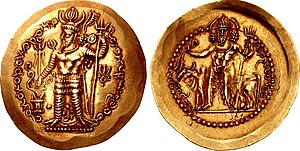Peroz II Kushanshah
| Peroz II Kushanshah | |
|---|---|
 | |
| Kushanshah of the Kushano-Sasanian Kingdom | |
| Reign | 303–330 |
| Predecessor | Hormizd II Kushanshah |
| Successor | Varahran Kushanshah |
| Died | 330 |
| Religion | Zoroastrianism |
Peroz II Kushanshah (Bactrian script: Πιρωςο Κοϸανο ϸαηο)[2] was the penultimate Kushanshah of the Kushano-Sasanian Kingdom from 303 to 330.[3] He was the successor of Hormizd II Kushanshah.
Like his two previous predecessors—Hormizd I Kushanshah and Hormizd II Kushanshah—Peroz II had the same group of coins minted during his reign, with gold dinars and copper drachms provided from the main Kushano-Sasanian base of Tukharistan.[4] However, Peroz II is called "the Great Kushan King" and not the "Kushan King of Kings" on his coins, hence renouncing their claim of kingship over the Sasanian Empire.[4] Since the reign of Hormizd I Kushanshah, copper drachms were minted with the names of two local governors, Meze and Kavad.[4] This was also continued under Peroz II.[4]
In Gandhara, Peroz II issued copper coins with his characteristic "bull horns crown".[5] However, he was the last of the Kushano-Sasanian rulers to issue such coins in Gandhara.[5] After that point, the area was occupied by Shapur II, who issued his own coinage from Kabul.[4][6][5]
Peroz II was succeeded by Varahran Kushanshah in Tukharistan, while the Sasanian King of Kings Shapur II (r. 309–379) incorporated Gandhara and Kabul into his own domains.[4][6][5]
References[edit]
- ^ Cribb 2010, pp. 98–99.
- ^ Cribb 2010, p. 98.
- ^ Cribb & Donovan 2014, p. 4.
- ^ a b c d e f Rezakhani 2017, p. 83.
- ^ a b c d Cribb 2010, p. 109.
- ^ a b Vaissière 2016.
Sources[edit]
- Cribb, Joe (2010). Alram, M. (ed.). "The Kidarites, the numismatic evidence.pdf". Coins, Art and Chronology Ii, Edited by M. Alram et al. Coins, Art and Chronology II: 91–146.
- Cribb, Joe; Donovan, Peter (2014). "Kushan, Kushano-Sasanian, and Kidarite Coins A Catalogue of Coins From the American Numismatic Society by David Jongeward and Joe Cribb with Peter Donovan". The American Numismatic Society: 4.
- Cribb, Joe (2018). Rienjang, Wannaporn; Stewart, Peter (eds.). Problems of Chronology in Gandhāran Art: Proceedings of the First International Workshop of the Gandhāra Connections Project, University of Oxford, 23rd-24th March, 2017. University of Oxford The Classical Art Research Centre Archaeopress. ISBN 978-1-78491-855-2.

- Daryaee, Touraj; Rezakhani, Khodadad (2017). "The Sasanian Empire". In Daryaee, Touraj (ed.). King of the Seven Climes: A History of the Ancient Iranian World (3000 BCE - 651 CE). UCI Jordan Center for Persian Studies. pp. 1–236. ISBN 978-0-692-86440-1.
- Rapp, Stephen H. (2014). The Sasanian World through Georgian Eyes: Caucasia and the Iranian Commonwealth in Late Antique Georgian Literature. London: Ashgate Publishing, Ltd. ISBN 978-1-4724-2552-2.
- Payne, Richard (2016). "The Making of Turan: The Fall and Transformation of the Iranian East in Late Antiquity". Journal of Late Antiquity. 9. Baltimore: Johns Hopkins University Press: 4–41. doi:10.1353/jla.2016.0011. S2CID 156673274.
- Rezakhani, Khodadad (2017). "East Iran in Late Antiquity". ReOrienting the Sasanians: East Iran in Late Antiquity. Edinburgh University Press. pp. 1–256. ISBN 978-1-4744-0030-5. JSTOR 10.3366/j.ctt1g04zr8. (registration required)
- Vaissière, Étienne de La (2016). "Kushanshahs i. History". Encyclopaedia Iranica.
